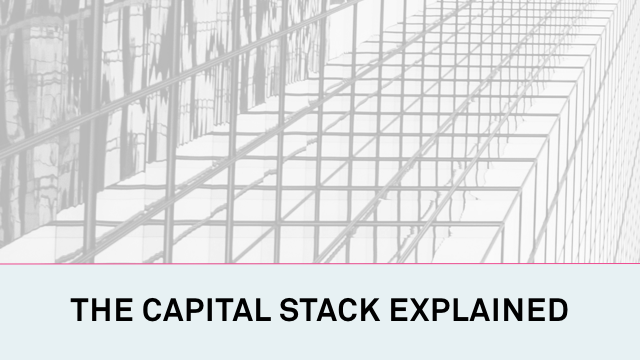Table of Contents
One of the most important jobs of a real estate sponsor is finding the sources of capital needed to finance a real estate transaction. Depending on the nature of the deal, as well as whether the acquisition is a fully stabilized asset or is in need of more substantial value-add renovations, the deal might require more or less equity. The risk profile of the deal will also influence how much traditional debt is available to finance the property.
The amount and structure of the capital used in a real estate transaction is referred to as the “capital stack”. In this article, we look at the different components of the real estate capital stack. Including the risk and returns to be expected at every level.
What is the Real Estate Capital Stack?
In real estate, the term “capital stack” refers to the combination of capital sources used to finance an investment. The capital stack can vary significantly from one deal to another. Both in the type of capital used and how much of each capital source is used.
For example, one deal may be entirely financed with equity. Another might have 60 percent senior debt, 15 percent mezzanine debt, and 25 percent equity. That equity can be broken down further between preferred equity and common equity. This is something we’ll examine in more detail below.
In real estate, the term “capital stack” refers to the combination of capital sources used to finance an investment.

One of the primary roles of a real estate sponsor is to identify the appropriate mix of capital sources when financing the acquisition and/or renovation of a commercial real estate deal.
Each sponsor has a different approach to leverage (i.e., debt). More conservative sponsors may look to use less debt than others. This means they will need to identify more or alternative sources of equity to make up the balance of the capital. Collectively, whatever combination of debt and equity is used to finance a deal is considered the capital stack.
Different Positions within the Real Estate Capital Stack
The real estate capital stack can be considered just that, a stack. Senior debt often falls at the bottom of the capital stack.
Mezzanine debt follows senior debt, followed by preferred equity and common equity. This is somewhat counterintuitive. Senior debt, as you’ll see below, sits in the “senior” position of the capital stack. When describing a capital stack, the senior position sits at the bottom and not the top.
 Senior Debt
Senior Debt
Senior debt is simply the name for any senior mortgage or loan used to finance a commercial real estate deal.
The senior debt is so called because it sits in the “senior” position. Meaning it has a recorded legal document entitling it to the first claim on the property’s cash flow and/or sales proceeds. Given senior debt is repaid first, it is considered to be the least “risky” position in the capital stack. In turn, it also has the least upside potential.
Senior debt is usually offered at a fixed rate amount with a fixed or floating interest rate that is repaid monthly. The balance is due at a predetermined time, usually, the end of the amortization period.
During the term of the loan period, if a sponsor is making monthly interest payments according to the amortization schedule, the individual or group who has made the senior loan on the property has no claim to any additional cash flow generated by the asset.
Upon sale or refinance, once the senior debt balance is repaid, the lender has no claim to any additional proceeds. Therefore, if a property exceeds initial return projections, the lender of senior debt will not benefit from any of those additional earnings.
If a property does not meet expectations, or if the monthly interest payments are not being repaid, the senior debt will be considered in default. When a sponsor defaults on senior debt, the lender can use various legal mechanisms to ensure their repayment.
Foreclosure
In the most extreme cases, the lender could force the sale of the property (via foreclosure). This is to ensure that they are repaid.
Foreclosure is often an action of last resort for senior debt holders. They are not in the business of owning and operating real estate. Generally they will lose money when they foreclose on a property.
Unlike the junior positions in the capital stack, a senior debt holder’s ability to foreclose typically prevents them from losing the entire value of their investment.
Lower risk
Senior debt’s priority position within the capital stack gives it a lower risk profile than other debt or equity investments in a deal. Therefore, most senior debt is provided by conservative investors such as traditional banks and life insurance companies.
From the perspective of a real estate equity investor, senior debt is an attractive component of the capital stack. This is simply because it can enhance the equity investors’ returns if the property performs well.
 Mezzanine Debt
Mezzanine Debt
Mezzanine debt, while sometimes referred to as “subordinate debt,” “sub-debt,” “junior debt” or simply just “mezz”. This is another form of debt used to finance commercial real estate deals. Mezzanine, which means “middle” in Italian, falls within the middle of the real estate capital stack.
Mezzanine debt is repaid after the senior debt but before any equity.
Mezzanine debt is issued similarly to senior debt in that it is issued as a fixed amount that carries a fixed or floating interest rate. Like senior debt, it also has a set repayment period.
Mezzanine debt is unique in that it can be issued as secured by the real estate, after the senior debt. Or alternatively it can be an unsecured loan. In the unsecured loan scenario, the mezzanine lender does not have the legal authority to force the sale of the property to recover its losses.
Mezzanine Debt vs. Senior Debt
Mezzanine debt behaves similar to senior debt in terms of the upside and downside scenarios. Both of which are capped based on the terms of the loan. The exception to this is in an extreme downside scenario: if a property drastically underperforms expectations; the senior debt is repaid first. The mezzanine debt lender is only repaid to the extent that there is the cash remaining after the repayment of the senior loan.
Mezzanine debt is often considered “safer” than preferred or common equity in that it will be repaid before equity investors see any of their earnings.
The returns on mezzanine debt reflect this moderate risk profile. Whereas senior debt might carry a 3 to 5 percent interest rate. Mezzanine debt may carry an interest rate of 8 to 14 percent. This is depending on the amount of leverage, current market conditions, and the deal’s overall risk profile.
Unlike senior debt, mezzanine debt is often provided by real estate equity investors who are comfortable owning and operating real estate. Given the risk of taking back the property is higher than if they were in the senior debt position. This is because, in a take back scenario, the margin of error for turning the property around in a way that allows them to recoup their investment is generally slim. Often it requires expertise and potentially additional resources to stabilize the asset.
 Preferred Equity
Preferred Equity
Preferred equity, often called “pref” for short, is in many ways similar to mezzanine debt but with a few key distinctions. First, preferred equity is never secured by the asset. The second difference is that preferred equity is usually structured as an equity investment into the entity (LLC, trust, etc.) that owns the real estate (vs. mezzanine debt which is structured as a loan to the ownership entity).
Given the many similarities between mezzanine debt and preferred equity. Often times, the two are rarely used at the same time within the same deal. If the common equity investors want to increase the amount of leverage beyond what the senior debtor is willing to provide, the sponsor will typically choose either mezzanine debt or preferred equity. Typically, they will not utilize both.
Aside from a few legal and accounting nuances, there is little difference between mezzanine debt and preferred equity. The pricing (about 8 to 14 percent) and investor profile (private equity real estate investors) are often the same, as is the mechanism for the preferred equity investor to take control of the investment from the common equity investor in the event of default on their agreement.
 Common Equity
Common Equity
In commercial real estate, when someone thinks of the “owner” of the real estate, they are generally thinking of those who have invested in common equity. Common equity can be commonly referred to as simply “equity”.
The common equity investors are primarily in control of the investment (subject to agreements with the other capital stack partners, if any). They’re also taking on the most risk, which is reflected in their position at the top of the capital stack.
If an asset underperforms, the common equity investors have the most to lose. They stand the greatest chance of losing their entire investment in a worst case scenario. Common equity is the last to be repaid, after senior debt, mezzanine debt and preferred equity investors.
Common equity investors are often the same groups that invest in mezzanine debt or preferred equity.
With greater risk comes the potential for greater reward. If an investment performs well, the common equity investors have the most to gain. The riskiness of this position is generally correlated with higher returns than the other capital stack investors would expect.
Yet unlike other capital stack positions, the returns are not tied to a pre-determined interest rate or preferred return on equity. Instead, they are projected by underwriting assumptions that attempt to predict how much cash flow will be left over for the common equity investors.
Common equity investors are often the same groups that invest in mezzanine debt or preferred equity. This includes private equity real estate investors, REITs, pension funds, sovereign wealth funds and individuals.
Applying the Real Estate Capital Stack
Real estate capital stacks can vary widely from deal to deal. That said, nearly all investments will have common equity since this reflects the equity of the “owners” in the deal.

On occasion, deals will be financed using all equity. However, most deals will utilize some combination of common equity and senior debt. This is the most common capital stack composition in the commercial real estate industry.
The ratio of common equity to senior debt will depend on the nature of the deal. This including the sponsor’s approach to leverage and risk tolerance (using more leverage is generally considered to be riskier than using less).
A smaller percentage of deals will use mezzanine debt or preferred equity, as well. No deals will use just mezzanine debt or preferred equity in the absence of senior debt. This is because senior debt is the most affordable type of leverage. Mezzanine debt or preferred equity are only used when a sponsor has maxed out their ability to obtain senior debt.
A common capital stack contains a modest amount of senior debt, ranging from 50 to 75 percent loan-to-value. The remaining portion of the capital stack will usually consist of common equity. In situations where mezzanine debt or preferred equity is being utilized. It will generally occupy the middle 10 to 20 percent of the capital extent.
To what extent the mezz or pref replaced the senior debt or common equity will depend on the risk appetites of the other capital partners involved in the deal.
Why is the Capital Stack Important?
How the capital stack is structured is critically important to the success of a real estate deal. The capital stack must be customized appropriately for each deal. This is something the real estate sponsor must navigate and build closely. An otherwise promising deal can fall apart if the wrong capital stack is employed.
For example, if the sponsor utilizes too much high cost mezzanine debt, and there is a major disruption in cash flow. The sponsor may have trouble making interest payments and will find themselves in default. A deal structured with more equity than debt will give the sponsor more time to adjust and stabilize the property without the risk of losing the property to lenders.
The capital stack is also important for investors considering the riskiness of their investment. Where they fall within the capital stack determines the investment’s risk profile. Those who invest in senior or mezzanine debt are taking on less risk than those who invest in preferred or common equity.
Conclusion
Anyone who is considering an investment in commercial real estate will first need to understand how the sponsor intends to structure the capital stack. Deals with significant leverage (e.g., 65-75% leverage) are inherently riskier than deals with less leverage. In the event of a market downturn, properties with less leverage tend to weather the downturn better than those that are highly levered.
Investors will want to consider their
own risk tolerance and return expectations
when considering where in the capital stack to invest.
Investors will want to consider their own risk tolerance and return expectations when considering where in the capital stack they should invest. Those with a lower risk tolerance may want to consider investing in debt, whereas those who are looking for more significant returns may want to invest in preferred or common equity despite the enhanced risk that often entails.
Are you interested in investing in commercial real estate? Contact us today to learn more about Smartland’s approach to leverage. Including how we go about structuring the capital stack for each of our deals.
FAQs
What is the capital stack?
It’s the mix of funding sources used to finance a deal, shown in a “stack” from lowest risk (senior debt) to highest risk (common equity). Each layer has different rights, returns, and repayment priority.
What are the common layers and their order of claims?
From bottom to top: senior debt, mezzanine debt, preferred equity, and common equity. Lower layers get paid first but earn lower returns; upper layers get paid last but target higher returns.
How do risk and return change as you move up the stack?
Risk generally rises with each layer above senior debt. Senior lenders are secured by the property and paid first; mezz and pref take more risk for higher coupons or preferred returns; common equity has the most upside and the last claim.
Where do preferred equity and mezzanine debt fit and what’s the difference?
Both sit between senior debt and common equity. Mezzanine is typically structured as debt with remedies if payments fail; preferred equity is an equity position with priority distributions and negotiated control rights.
Why does the capital stack matter for LPs?
It shapes cash flow, control, and downside protection. Leverage levels, covenants, and intercreditor terms affect distribution timing and recovery in a downside, while equity layers determine how profits are split.
What should I review before investing?
Check total leverage (LTV), DSCR, interest terms and maturities, whether there’s mezz or pref in the mix, fees, recourse, and how the waterfall allocates profits across layers. Make sure assumptions match the business plan.




